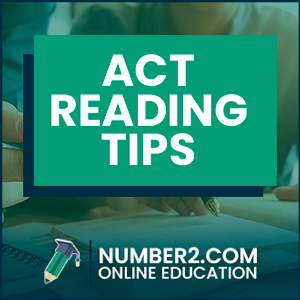 Strategies & Tricks to Ace the ACT Reading Section Test
Strategies & Tricks to Ace the ACT Reading Section Test
The ACT Reading section is the third test of the ACT exam comprising of 750-word passages. Each passage has ten questions, and like the other ACTs, this can be daunting. In reality, the test is doable. You just have to be resourceful, methodical, and quick in answering the 40 passage questions in 35 minutes.
Acing the reading section revolves around being able to quickly read the passages, retaining the info, and mastering multiple-choice question techniques that you will need to ace the Reading ACT.
Let’s talk about some of the best tips for the ACT Reading test and ways you can increase your ACT test score.
10 ACT Reading Section Tips that You Need to Know
Here’s a list of the top 10 ACT Reading tips to improve your ACT test score.
- Read the Entire Passage
- Read the Entire Question
- Watch the Clock
- Don’t Forget the Line References
- Use Practice Tests
- Don’t be Afraid to Guess
- Practice Reading
- Rule out Wrong Answers
- Find the Answer in the Passage
- Don’t Stop
General ACT Reading Tips
Tip #1: Read the Entire Passage
Always read the pass first. Reading the entire passage is crucial to understanding it and remembering the details. Too many students think they can skim the passage or read pieces of it. That’s not enough to answers the questions quickly or correctly. You need to read it completely!
Tip #2: Read the Entire Question
Always read the question after reading the passage. Many students think they can save time by reading the questions and then searching for the answers. It doesn’t work that way. You end up spending more time doing this because you can’t find the answers quickly.
Tip #3: Don’t Reread Passages
If you read part of a passage and don’t understand what it is talking about, don’t go back to reread it. Chances are you won’t be able to understand it the second time and you will waste precious time doing it. Read the passage and keep moving to the next section. The questions won’t ask you technical things about the passage. You don’t need to know that kind of detail.
Tip #4: Don’t Forget the Line References
You can’t remember everything during the test. It’s impossible. Use the line references and read the surrounding context for more info. There’s a reason why the ACT has line references.
Tip #5: Use Practice Tests
One of the best ways to prepare for the reading section is to read through the practice tests and work the questions. Make sure when you do the practice tests that you time yourself. You need to get the hang of being under pressure. That’s key.
Tip #6: Don’t be Afraid to Guess
One thing to always remember is that wrong answers don’t count against you. If you don’t know the answer or can’t find the answer in the passage quickly, just guess and move on. There’s no point wasting time when you can move on to other questions that you can answer correctly.
Tip #7: Practice Reading
The best way to improve your reading skills is to simply practice. Get some books from the library and just read. Read a novel, or a news article, or a magazine. Read anything. Just practice reading. Also, try to time yourself during your reading sessions and document how long it takes you to read certain length articles.
Tip #8: Rule out Wrong Answers
Sometimes the correct answer isn’t always apparent, but there are clearly several wrong answers. Rule out the wrong answers and try to answer the question by process of elimination.
Tip #9: Find the Answer in the Passage
This is a tricky tip because you don’t want to spend too much time looking for answers in the passage, but it can be helpful to go back to a specific spot if you know the answer is there. If you can find the answer, you know you will be correct.
Tip #10: Don’t Stop
Don’t stop reading! Don’t stop to think about something else. Don’t let your mind wonder. Just keep reading. You need to get through the passages as fast as possible to give yourself enough time to answer the questions.
What is the ACT Reading Section?
The ACT Reading section is the third part of the ACT comprising 40 questions that you should answer in 35 minutes. Notably, the test comprises three single passages, plus a paired passage set, usually in humanities or prose fiction. Each section has ten multiple questions accompanying it. The part containing paired passages includes questions involving both essays in the section.
Most importantly, there are two ACT Reading question types which are reasoning and referring questions. Reasoning questions require the student to draw inferences from the passage’s information, and referring questions require information regarding what the passage contains.
Therefore, you have around 52 seconds to answer each question, but it could even be less because you will use most of your time reading. Interestingly, there are four multiple answer categories to each question that are either A, B, C, D or F, G, H, J.
What is Topics Covered on the ACT Reading Section?
The section’s primary focus is testing the candidate’s ability to read, analyses, and comprehend the passage. However, the section can sometimes have questions about specific writing styles and techniques used in each passage. Therefore, you should be familiar with the narrative and literary concepts learned during language Art studies.
Some of the skills tested include the passage’s overall style or tone and the narrator or author’s voice.
Mostly, the student will be asked to give interpretations of things such as a sequence of events, main ideas in the passage, comparisons, important passage details, meaning of context-dependent phrases, statements and words, cause-effect relationships, and other general things.
Passages Types
the five passages cover natural sciences, social sciences, humanities, and literary narrative/prose fiction. You don’t need any pre-existing knowledge regarding the passage topics, and everything you require to respond to the questions will be in the text.
The topics cover a range of subtopics, and social studies passages will be from a textbook, while natural sciences passages will be from given scientific articles. On the other hand, a humanities passage from a memoir or essay, and literary narrative /prose fiction from a novel.
The subtopics covered in each section include:
Natural sciences comprise astronomy, anatomy, botany, biology, ecology, chemistry, geology, and meteorology. Other areas include medicine, natural history, microbiology, zoology, physiology, physics, and technology.
Social sciences comprise archaeology, business, anthropology, economics, biography, education, psychology, political science, geography, sociology, and political science.
Prose fiction/literary narrative entails short stories, memoirs, excerpts from novels, and personal essays.
Humanities comprise art, architecture, film, language, ethics, music, literary criticism, radio, philosophy, theatre, and television.
Question Types
The ACT Reading section questions are categorized into three types. They include key details and ideas, craft and structure, as well as knowledge integration.
Key details and ideas questions account for around 55-60% of the questions, and they are 22 to 24 questions. These questions entail finding and interpreting details of a passage, paragraph, or paragraph.
Craft and structure questions account for 25-30% of the test, and they are around 10-12 questions. The category focuses on word usage within the passage, organization of the text and the passage structure contributes to the overall meaning.
Integration and knowledge questions are around 13-18% and are between 5 and 7 questions. This part involves deciphering how ideas have been presented in the text. It would help if you critically examined the assertion made in the text and how it supports the assertion based on objective or bias knowledge.
Who Should Take the ACT Reading Section?
The ACT exam is taken by students who have finished high school, preparing for their next stage of life, in trade school or the workforce. For those considering joining a college in the US, you have to prepare for that goal by taking the ACT. You should demonstrate that you can handle a college education before applying by sitting the ACT.
This is a reading part, and you should bring different skills to decipher and respond to questions. Some of the skills you should have including understanding ideas, locating and interpreting details in a passage, comparisons, interpreting sequence of events, understanding cause-effect relationships, and drawing generalization.
How is the ACT Reading Test Graded?
The ACT has four parts, and each subject area receives a scaled score between 1 and 36. These scaled scores are then averaged into a composite score ranging between 1 and 36. The scaled scores are arrived at from the raw score for each subject area, and the raw score represents the total number of questions you got right. Most importantly, there is no wrong answer in the test.
The reading test has subscores besides the ACT composite score ranging from 1-18, which are also scaled from the raw score. Interestingly there is no relationship between the subscore and the final scaled score.
Most importantly, colleges only focus on composite ACT scores. Reading has 40 questions, and therefore the highest raw score to can get is 40. Subscores are given for the four categories of passages.
ACT Reading Testing Fees
The cost for taking the exam includes
- Registration Full ACT (with writing) – $70 (includes reports for you, high school, and four colleges)
- Registration Full ACT (no writing) – $55 (includes reports for you, high school, and four colleges of choice)
- Test change $15 (to switch to ACT with writing)

